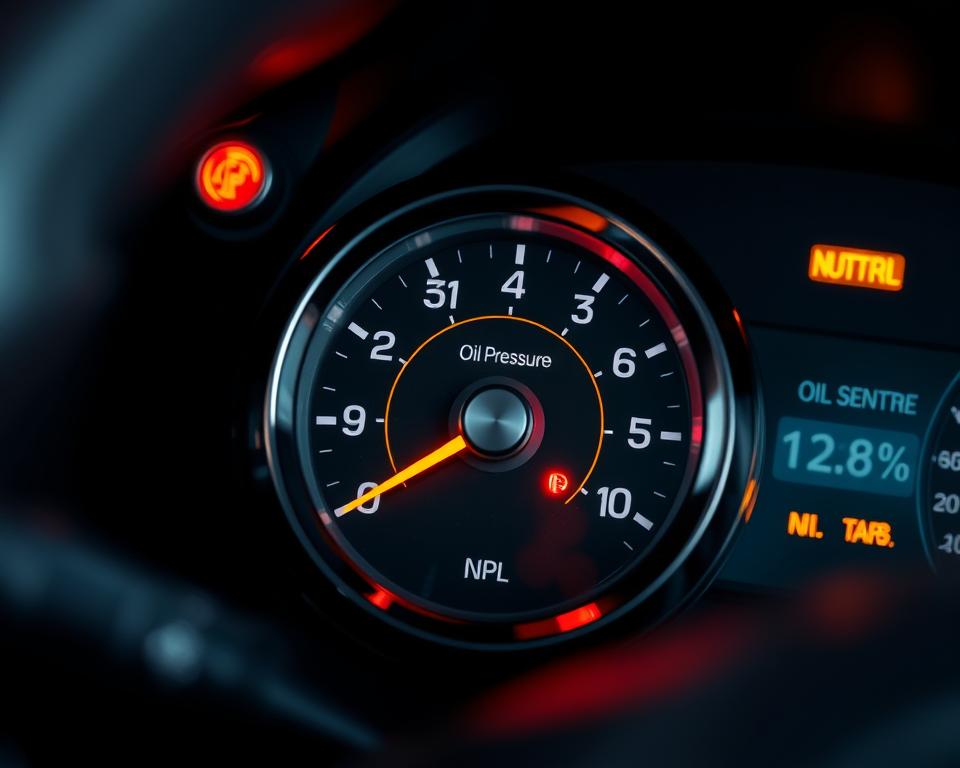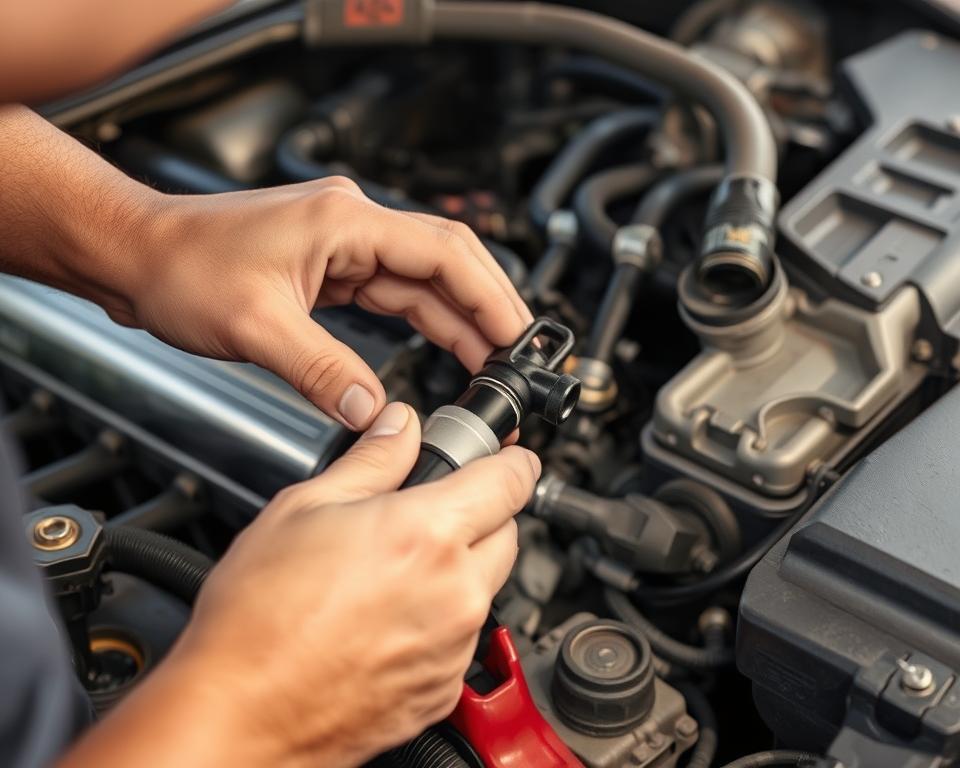
Oil Pressure Gauge: Essential Engine Health Monitor
The oil pressure gauge is key in any vehicle. It shows important info about the engine’s lubrication system. By watching the oil pressure, drivers can spot problems early and fix them before they get worse.
This gauge acts as a live alert for the engine’s oil pump pressure. It warns the driver of any odd readings that could harm the engine’s life and performance.
Read interesting things at : revolutionbookscamb
Key Takeaways
- The oil pressure gauge is a critical component for monitoring engine health and performance.
- Maintaining proper oil pressure is essential for engine lubrication and longevity.
- Low oil pressure can indicate serious issues like worn bearings, oil pump failure, or oil leaks.
- Regularly checking the oil pressure gauge can help identify problems early and prevent costly engine repairs.
- Understanding how an oil pressure gauge works and interpreting its readings is crucial for effective engine maintenance.
Understanding the Significance of Oil Pressure
The engine oil pressure is key to your vehicle’s health and performance. It helps the engine lubrication system work well. This ensures that important engine parts get the oil they need.
Having the right engine oil pressure is vital. It cuts down on friction, wear, and damage to the engine.
Why Oil Pressure Matters
The oil pump pressure keeps oil moving in the engine. This oil acts as a shield between moving parts. It prevents metal-on-metal contact and damage.
High oil pressure means your lubrication system is healthy. But low oil pressure can cause friction, wear, and even engine failure.
Effects of Low Oil Pressure
- Increased engine wear and tear
- Reduced engine efficiency and performance
- Higher risk of engine component failure
- Potential for engine seizure or catastrophic damage
- Activation of the low oil pressure warning light on the dashboard
Keeping the engine oil pressure right is essential. It helps your engine last longer and run better. Knowing how important oil pressure is can help you keep your engine in top shape.
What is an Oil Pressure Gauge?
An oil pressure gauge is key in any vehicle. It watches over the engine’s oil system health and performance. This tool shows the oil pressure in the engine, helping us understand how well it’s working.
Components of an Oil Pressure Gauge
There are two main parts to an oil pressure gauge:
- Oil Pressure Sensor: This part finds out the oil pressure in the engine. It’s usually near the oil pump or in the oil gallery. This lets it measure the oil pressure accurately.
- Display Unit: The display unit shows the oil pressure reading. It’s on the dashboard or instrument cluster. This lets the driver see the oil pressure as it changes.
The oil pressure sensor sends a signal to the display unit. The display unit then shows this as a number or a line, so the driver can see the engine’s oil pressure.
“The oil pressure gauge is the engine’s heartbeat, providing vital information about the overall health and performance of the lubrication system.”
How an Oil Pressure Gauge Works
An oil pressure gauge is key for checking your car’s engine health. It shows the oil pressure in real time. This helps spot problems early, before they get worse.
The oil pressure gauge works simply. It’s linked to a pressure sensor in the engine’s oil system. This sensor always checks the oil pressure and sends the info to the gauge. The gauge then shows the current pressure to the driver.
The sensor is usually near the oil pump. This is where the oil pressure is highest. So, the gauge can warn of any changes in pressure. This could mean there’s a problem with the engine’s oil system.
| Component | Function |
|---|---|
| Pressure Sensor | Measures the oil pressure and sends a signal to the gauge |
| Oil Pressure Gauge | Receives the signal from the pressure sensor and displays the current oil pressure reading |
| Engine Oil System | Supplies the oil that is monitored by the pressure sensor |
Knowing how an oil pressure gauge works helps drivers understand its readings. This knowledge lets them take care of their engine’s oil system. It ensures the engine runs well and lasts longer.
Types of Oil Pressure Gauges
An oil pressure gauge is key for checking your engine’s health. There are two main types: mechanical and electronic. Knowing the differences helps you choose the best one for your car.
Mechanical Oil Pressure Gauges
Mechanical gauges, or analog gauges, use a Bourdon tube to measure oil pressure. This tube connects to the engine’s oil line. As oil pressure goes up, the tube expands, moving the needle to show the pressure.
These gauges are tough and reliable. They’re loved by car enthusiasts and mechanics for their clear, hands-on feedback.
Electronic Oil Pressure Gauges
Electronic gauges, on the other hand, use a pressure sensor. This sensor, near the oil pump, sends a signal to a digital display. The display shows the oil pressure clearly.
Electronic gauges are more accurate and can connect with your car’s systems. They’re great for those who like modern tech and easy-to-read displays.
| Feature | Mechanical Oil Pressure Gauge | Electronic Oil Pressure Gauge |
|---|---|---|
| Technology | Bourdon tube | Pressure sensor |
| Display | Analog | Digital |
| Accuracy | Moderate | High |
| Integration | Limited | Advanced |
| Preferred by | Enthusiasts, mechanics | Modern vehicle owners |
Choosing between a mechanical or electronic oil pressure gauge depends on your needs and car. Think about what you need and what fits your car best. This ensures your engine stays healthy.
Interpreting Oil Pressure Gauge Readings
Knowing what your oil pressure gauge shows is key to keeping your engine in top shape. The normal oil pressure range can change based on several things. But usually, it’s between 20-80 psi.
Normal Oil Pressure Range
The exact normal oil pressure range for your car depends on a few things. These include the engine type, engine temperature, and how you drive. Here’s a general idea of what you might see on your oil pressure gauge:
- Cold engine: 30-80 psi
- Warm engine (normal operating temperature): 20-50 psi
- High-performance engines: 40-80 psi
- Older or high-mileage engines: 10-30 psi
Remember, the normal oil pressure range can differ for each car. It depends on the make, model, and year. Always check your owner’s manual or talk to a trusted mechanic to find out the best oil pressure for your engine.
Watching your oil pressure gauge closely is important. Knowing the normal range helps spot engine problems early. By keeping an eye on your oil pressure and fixing any issues, you can make your engine last longer. And avoid expensive repairs.
Symptoms of Low Oil Pressure
The oil pressure gauge in your vehicle is key to knowing your engine’s health. If the oil pressure falls below normal, it might mean a problem with the engine lubrication system. Knowing the signs of low oil pressure can help you fix issues early and avoid serious engine damage.
One clear sign of low oil pressure is the low oil pressure warning light on your dashboard. This light is there to warn you of any engine lubrication system problems, urging you to act fast.
- Reduced engine performance: With lower oil pressure, the engine parts may not get enough lubrication. This can cause more friction and less power.
- Unusual engine noises: Low oil pressure can make the engine sound odd, like knocking, tapping, or whining. This is because the parts are rubbing against each other without enough oil.
- Increased engine wear: Going on for too long, low oil pressure can wear down engine parts faster. This means more repairs and a shorter engine life.
It’s important to deal with low oil pressure quickly to avoid more engine damage. If you see any of these signs, get your car checked by a skilled mechanic to find and fix the problem.

“Ignoring the signs of low oil pressure can lead to catastrophic engine failure, costing you thousands in repairs. Stay vigilant and address any oil pressure concerns immediately.”
Causes of Low Oil Pressure
Keeping an eye on the oil pressure is key for a healthy engine. Low oil pressure can signal serious problems that need quick action. Knowing what causes low oil pressure helps fix the issue and get the engine running right again.
Common Culprits
Many things can lead to low oil pressure in an engine. Here are some common reasons:
- Oil Leaks: Leaks in the oil system, like damaged gaskets or seals, can cause oil loss and low pressure.
- Worn Oil Pump: The oil pump wears out over time, making it less efficient and leading to low oil pressure.
- Clogged Oil Passages: Sludge or debris in the engine’s oil passages can block oil flow, causing low pressure.
- Excessive Engine Wear: As an engine gets older, parts wear out, increasing clearances and lowering oil pressure.
It’s vital to find and fix the cause of low oil pressure to keep the engine well-lubricated. Proper troubleshooting and maintenance are key for the engine’s long life and performance.
Troubleshooting Low Oil Pressure Issues
When you notice low oil pressure, it’s crucial to find and fix the problem. Start by checking the oil level in your engine. If it’s low, adding more oil might solve the issue. But if the problem persists, you need to dig deeper.
Next, look at the oil pump for any damage. A bad oil pump can really lower the oil pressure, which can harm your engine. Check the pump for problems and replace it if needed.
- Check the oil level
- Inspect the oil pump
- Diagnose oil leaks or blockages
- Assess the condition of the oil
- Inspect the oil pressure sensor
It’s also key to find any leaks or blockages in the lubrication system. Leaks can drain oil, and blockages can slow it down. Look for any problems in the system and fix them.
| Troubleshooting Step | Description |
|---|---|
| Check Oil Level | Ensure the oil level is within the recommended range and top up if necessary. |
| Inspect Oil Pump | Examine the oil pump for any signs of wear or damage and replace if needed. |
| Diagnose Leaks/Blockages | Thoroughly inspect the lubrication system for any leaks or blockages and address them. |
| Assess Oil Condition | Check the oil for contamination, viscosity issues, or other signs of deterioration. |
| Inspect Oil Pressure Sensor | Ensure the oil pressure sensor is functioning correctly and replace if necessary. |
By using a detailed oil pressure troubleshooting plan, you can find and fix the low oil pressure problem. This helps keep your engine’s lubrication system healthy and running well.
Oil Pressure Gauge Maintenance
Keeping your oil pressure gauge in good shape is key. It helps you get accurate readings and spot engine problems early. A big part of this is checking and replacing the oil pressure sensor regularly.
Replacing the Oil Pressure Sensor
The oil pressure sensor sends info about the engine’s oil pressure to the gauge. It can wear out or stop working, causing wrong readings or a broken gauge.
To replace it, follow these steps:
- Find the oil pressure sensor, usually on the engine block or near the oil filter.
- Take off the electrical connector from the sensor.
- Use a wrench or socket to remove the old sensor.
- Put a bit of thread sealant or oil on the new sensor’s threads.
- Put the new sensor in the engine block and tighten it well.
- Connect the electrical connector back and make sure it’s secure.
- Start the engine and look for leaks around the new sensor.
Replacing the oil pressure sensor is easy with basic tools. Keeping your gauge in good shape means it will give you reliable info about your engine’s oil.
| Maintenance Task | Recommended Frequency |
|---|---|
| Check oil pressure sensor | Every 6 months or 5,000 miles |
| Replace oil pressure sensor | Every 2-3 years or as needed |

By following these tips and fixing oil pressure sensor problems fast, your gauge will keep giving you accurate info. This helps you keep an eye on your engine’s oil system health.
The Importance of Regular Oil Changes
Keeping the oil pressure right and protecting the engine’s lubrication system is key for any vehicle’s health. Skipping oil changes can cause big problems. These include oil getting old, thickening, and not flowing well, leading to low oil pressure and engine damage.
It’s vital to change oil regularly to keep the oil pressure just right. Old, dirty oil can’t lubricate the engine well. This leads to more friction, heat, and a drop in oil pressure. This can harm the engine and shorten its life.
- Maintaining proper oil pressure helps to:
- Reduce engine wear and tear
- Improve fuel efficiency
- Extend the engine’s lifespan
- Neglecting oil changes can lead to:
- Increased oil viscosity, reducing oil flow
- Buildup of contaminants, hampering the engine lubrication system
- Potential engine damage due to low oil pressure
By being consistent with oil changes, car owners keep their engines running smoothly. They ensure their engines stay in top shape for many years.
“Regular oil changes are the single most important maintenance task for preserving engine health and performance.”
| Benefit | Description |
|---|---|
| Oil Pressure Maintenance | Ensures proper lubrication and reduced wear on engine components |
| Engine Lubrication System Protection | Prevents buildup of contaminants and preserves the integrity of the engine’s oil passages |
| Increased Engine Lifespan | Regular oil changes extend the engine’s operational lifespan by mitigating the effects of wear and tear |
Oil Pressure Gauge and Engine Performance
The oil pressure gauge is key for checking engine health. It also helps understand engine performance. Drivers can spot changes that show engine issues.
Right oil pressure is vital for the engine’s smooth work. Low oil pressure can cause friction, heat, and damage. High pressure can lead to leaks and strain on parts.
Drivers can learn a lot from oil pressure gauge readings. A sudden drop might mean oil pump trouble, worn bearings, or leaks. High pressure could show a blockage or a faulty valve.
Watching the oil pressure gauge and keeping up with oil changes helps the engine. This way, drivers can keep their car running well and enjoy driving more.
“Maintaining proper oil pressure is crucial for keeping your engine running at its peak performance.”
In summary, the oil pressure gauge is more than just a monitor. It’s a tool for improving engine performance. By watching oil pressure, drivers can fix problems early and keep their car running great.
Choosing the Right Oil Pressure Gauge
Choosing the right oil pressure gauge is key to keeping an eye on your engine’s lubrication system. You need to think about a few things to get accurate readings and good performance.
Factors to Consider
When picking an oil pressure gauge, remember these important points:
- Gauge Type – There are mechanical and electronic gauges. Mechanical ones use a physical part to measure pressure. Electronic ones use sensors and digital screens.
- Pressure Range – Make sure the gauge’s range fits your engine’s needs. The right range gives you the most accurate and helpful readings.
- Size and Placement – Think about the gauge’s size and where it will go in your car. It should be big enough to see and easy to get to.
- Compatibility – Check if the gauge works with your engine and car model. Some might need extra wiring or changes to fit right.
By looking at these points, you can pick an oil pressure gauge that helps keep your engine’s lubrication system healthy. It will also give you important info on how well it’s doing.
“Choosing the right oil pressure gauge is essential for maintaining the integrity of your engine’s lubrication system and ensuring optimal performance.”
Conclusion
The oil pressure gauge is key to an engine’s health. It shows how well the engine is working. Knowing how to read the gauge helps drivers keep their engines running smoothly.
Checking the oil pressure gauge often can spot problems early. This lets drivers fix issues before they get worse. It also saves money on big repairs later.
In short, the oil pressure gauge is essential for a well-running engine. Taking care of it means a better, longer-lasting driving experience.









Leave a Reply